 |

State of Alaska > DOLWD > Alaska
Economic Trends
1996 Alaska Economic Trends
Alaska Economic Trends are searchable from 1978 to the present using the Trends search page. The search can include any combination of the title or subtitle, date or date range, author, or full text.
|
| December
1996 |
Alaska Occupational Outlook to 2005 |
| |
A laska's occupational employment, including both wage and salary employment and self-employment, is projected to increase 14.8%, from 276,075 to 316,983, between 1994 and 2005. The nature of the jobs that will be generated by this growth reflects a variety of factors that will affect the economy and the job market. Some factors, such as the expected declines in crude oil production, timber harvesting, and seafood processing, will reduce employment in some industries and occupations. Other factors, such as the projected growth in hard rock mining and boosts in the transportation and trade industries, will cause other occupations to increase.
December 1996 Trends |
| |
|
November
1996 |
Income and Wage Gains are Slow
to Come |
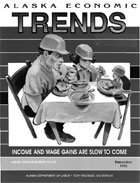 |
In 1995, all Alaskan residents-that is, its men, women and children-earned $14.5 billion. During the same year, they also became $357 million dollars richer. These appear to be impressive earnings, and by some measures they are. For example, dividing total state income by the state's entire population, each man, woman and child earned on average $24,002 in 1995. However, looking over the past two decades, this represents considerable slowdown in the rate of growth for income. (See Figure 1.) During most of the nineties, Alaska's gains in personal income have lagged behind those of the rest of the nation.
November 1996 Trends
|
| |
|
October 1996 |
A Trends Profile -
Bethel Census Area |
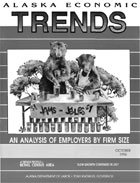 |
The Bethel census area, at 41,087 square miles, is Alaska's third largest region. Only the Yukon-Koyukuk census area and the North Slope Borough encompass more land. The Bethel census area, with 15,367 residents, is also the most populated of Alaska's remote areas. (See Table 3.) The city of Bethel is home to over one-third of the area's population, and the remaining residents live in 36 communities throughout the region.
October 1996
Trends |
| |
|
| September
1996 |
Federal Agencies Prominent
Despite Downsizing |
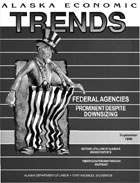 |
The federal government (including uniformed military personnel) has been the largest employer in Alaska since the military build-up associated with World War 11. As late as 1970, it provided almost one in every five civilian wage and salary jobs. As oil and other industries rose to prominence in the 1970s, federal government's share of employment declined. However, despite recent downsizing, the federal government (including the military) is still the largest single employer in Alaska's job base. In all, more than 37,000 individuals had federal government jobs in Alaska in 1995.
September 1996 Trends
|
| |
|
| August 1996 |
Alaska's Largest 100 Private Employers
in 1995:
The Trends 100 |
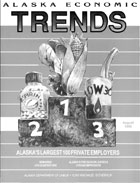 |
For the past five years, Carr Gottstein Foods has topped the list of Alaska's largest employers. In 1995, the employment count at Carr's stood at 3,222, putting it in a league of its own. In fact, the runner up was Providence Hospital, which came in just shy of 2,000. Given this lead, Carr's is likely to top the list for many years to come.
August 1996 Trends |
| |
|
| July 1996 |
A View of Alaska's Air Transportation Industry |
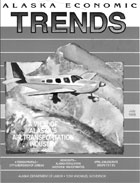 |
During the past two years, Alaska's airline industry has attracted much attention. Over 80 years ago when the first plane arrived in the Territory, the industry began to excite Alaska's collective consciousness. To this day, this excitement has not diminished. Grasping the potential of air transportation was almost immediate. Since 1922, when Roy Jones of Ketchikan set up the state's first commercial airline, the industry has made its big mark on the economy.
July 1996 Trends |
| |
|
June 1996 |
Measuring Alaska's Cost of Living |
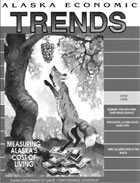 |
How expensive is it to live in Alaska? How much has Alaska's cost of living increased? These are two of the most frequently asked questions of the Alaska Department of Labor's Research and Analysis section. In answer to these questions, this article provides some of the latest cost-of-living measurements available for Alaska and explains the uses and limitations of these data.
June 1996 Trends |
| |
|
May 1996 |
Alaska Forecast: 1996-97
Slow Job Growth to Continue |
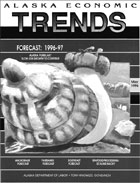 |
Alaska's economy will continue to grow slowly during 1996 and 1997, extending an eight-year string of job gains for two additional years. The industries critical to job growth during this period are hard rock mining, services, trade, and the visitor sector. Slower projected job growth in services and trade is a key factor in the outlook for sluggish job growth. On the down side, Alaska's public sector, segments of the oil and gas industry, and the manufacturing sector will contract, offsetting job gains in other industries. In spite of the negative factors, positive influences on the economy will tip the balance toward job increases. However, the result will be meager overall job growth that falls under the 1.0 percent mark.
May 1996 Trends
|
| |
|
April 1996 |
The Year in Review -
Job Growth Wanes in 1995 |
 |
Alaska's economy grew for the eighth straight year in 1995, propelled by an expanding services sector and strong construction activity. (See Figure 1.) However, job growth was slower than at any time during the 1990s. Wage and salary jobs grew by 1.1%, less than half of the 2.5% pace set in 1994. Oil and timber industry woes combined with federal government downsizing and the demise of two airlines to put a damper on employment growth. Slower growth in Alaska's retail sector completed the recipe for one of the more sluggish economic performances in recent memory.
April 1996 Trends |
| |
|
March 1996 |
Alaska Seafood Processing -
A Growing Job Source? |
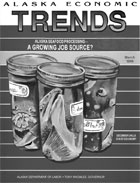 |
Seafood processing is one of Alaska's earliest industries. Alaskan Natives processed fish and traded their surplus with other tribes. The first commercial fish canning operations opened in 1878, and by the turn of the century almost 50 canneries operated in the Alaska territory. At one time, about 75 percent of taxes from the Territory of Alaska came from canned salmon.
March 1996 Trends |
| |
|
February 1996 |
A Trends Profile - Kodiak Island |
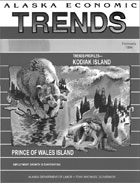 |
The description of Kodiak as the Emerald Isle not only hints at its scenic beauty but also alludes to the abundant ocean resources in its surrounding waters. While fishing provides Kodiak's economic base, other industries such as timber, tourism, and especially the Coast Guard's presence sustain and promote growth in the construction, retail and service industries.
February 1996 |
| January 1996 |
Case Study of a Layoff -
Life After Greens Creek |
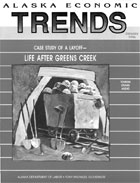 |
The announcement of an impending cutback or closure of a large employer invokes many fears i n t h e affected community and its residents. For employees, the imminent prospect oflost wages and benefits stirs up frightening questions about their future economic security. This apprehension in turn infects the community around them.
January 1996 |
Return to Top of Page
|















